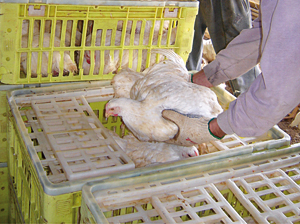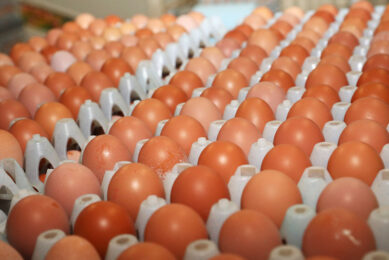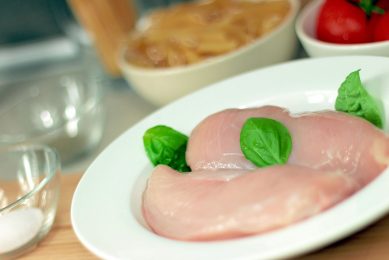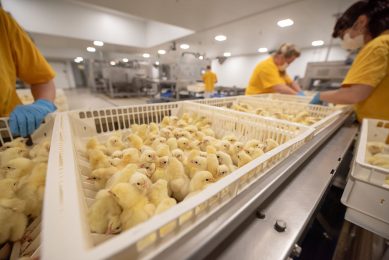Reducing downgrading starts with capturing

Keeping the rate of downgrades in the processing plant at the lowest possible level, greatly determines the benefits of poultry producers. That starts with capturing the birds at the farm. The implementation of proper measures will drastically decrease the amount of downgrades. The result is an increase of top grade kilos produced and a reduction of the cost per kilo processed, thus maximising profitability.
By Eduardo Cervantes Lopez, International processing consultant, Barranquilla, Colombia
In the broiler industry, three systems to catch birds have traditionally been used. These methods are classified depending on the part of the chicken’s body. By far the most popular method of catching chickens is grabbing by the legs. People wrongly believe this is the fastest method for capturing, but in fact it produces the highest percentage of downgrading. The birds are caught by a leg and they are held in groups of up to five in one hand, depending on the chicken’s weight and environmental conditions.
When the worker has captured the required number of birds, he walks (or sometimes runs) to the truck. The birds are then either put into crates or they are handed over to another worker. The second worker (firmly) grabs the chicken by the leg/thigh joint, which immediately causes some bruising. This quality defect is evident after de-feathering in the form of a red circular mark on the skin caused by the excess pressure in the grip. After freezing, this red mark becomes darker and unpleasant for customers. Additionally, grabbing the birds by the leg and rotating the hip joint 180 degrees, causes physical damage.
The femur head, which is welded to the hip, is detached. In this case, the bone descends and might occasionally break some of the abdominal sacs. This can interfere with the respiratory and circulatory system, which may cause internal haemorrhages in the inner thigh area.
While being grabbed by a leg, birds will attempt to escape. They flap incessantly and might hurt their wings. Moreover, if during transportation to the crates area, chickens hit against other elements such as feeders, drinkers, doors, etcetera, additional injuries may occur.
Downgrading is not the only negative impact: this capture method demands greater effort from the workers. They might try to finish as fast as possible, thus not taking enough care of the task they are performing. The quicker they can load the truck the sooner they can get some extra rest, before the next truck arrives. The capture operation then becomes a race against time.
Grabbing whole body the best
When grabbing the birds by the neck and head, workers hold them between their fingers until they are placed inside the cages. This method prevents the birds from flapping their wings, so the percentage of downgrading is lower. However, holding the chicken by the head generates high pressure and causes bruising around the neck, which can easily be observed after de-feathering.
Holding the chicken by the head generates high pressure and causes bruising around the neck.
In markets where the head and neck are saleable, customers regard these bruises as a sign of lower quality. When fresh, a red mark is visible on the flesh; when frozen, the red mark turns into a darker colour, due to muscular contraction.
Definitely the best capture method is grabbing the bird by the whole body. By doing so, the wings are kept closed against the body (therefore avoiding flapping) and the legs remain in a natural position. No harm is done to the thighs or hips. Additionally, capturing and putting inside crates, two birds at a time, demands less effort from workers, since they will not be walking more than four metres round trip. Therefore the performance of workers remains more stable throughout the day.
Skilled capturing crew
Thus, it is clear that capturing birds properly demands a skilled approach. A 12-person capture crew will be able to unload the crates, capture, cage and load 3,000 chickens onto a truck in 45 to 60 minutes. During the different stages of this method, grabbing the birds by the whole body, the catchers should work as follows:
Thus, it is clear that capturing birds properly demands a skilled approach. A 12-person capture crew will be able to unload the crates, capture, cage and load 3,000 chickens onto a truck in 45 to 60 minutes. During the different stages of this method, grabbing the birds by the whole body, the catchers should work as follows:
Unloading and construction of the ring-fenced area
Two workers stay on the truck moving the cages and sliding them down the ramp. Ten catchers then move the crate stacks over an array of plastic pipes (5 cm diameter, 0.6 cm wall thickness). The pipes must remain wet at all times, in order to reduce friction. The chickens need to be separated in two ring-fenced areas, one at each side of the chicken house, built using stacks of crates. Each area must be 2 m x 3 m in size. This takes about 15 minutes. Once all birds are ring-fenced, eight workers grab the chickens by the body and put them inside the crates. Four workers ensure that full cages are immediately replaced by empty ones so that the operation can continue seamlessly until all birds are caged. This takes about another 30 minutes.
Two workers stay on the truck moving the cages and sliding them down the ramp. Ten catchers then move the crate stacks over an array of plastic pipes (5 cm diameter, 0.6 cm wall thickness). The pipes must remain wet at all times, in order to reduce friction. The chickens need to be separated in two ring-fenced areas, one at each side of the chicken house, built using stacks of crates. Each area must be 2 m x 3 m in size. This takes about 15 minutes. Once all birds are ring-fenced, eight workers grab the chickens by the body and put them inside the crates. Four workers ensure that full cages are immediately replaced by empty ones so that the operation can continue seamlessly until all birds are caged. This takes about another 30 minutes.
Loading the crates onto the truck
Two workers place the crate stacks over a small platform, similar to an elevator, which rises them to the truck bed in about six seconds. This setup eliminates the strain of moving four to five crates up the ramp. Four people stay on the truck: two people receive from the rising platform the crates and the other two build and organise the stacks. Six people move the full crates over the pipe distribution array and place them beside the rising platform. This takes about 15 minutes. If everything goes well, the time taken to perform the complete operation can be reduced from 60 to 45 minutes.
Two workers place the crate stacks over a small platform, similar to an elevator, which rises them to the truck bed in about six seconds. This setup eliminates the strain of moving four to five crates up the ramp. Four people stay on the truck: two people receive from the rising platform the crates and the other two build and organise the stacks. Six people move the full crates over the pipe distribution array and place them beside the rising platform. This takes about 15 minutes. If everything goes well, the time taken to perform the complete operation can be reduced from 60 to 45 minutes.
Good quality crates essential
The good condition of the crates is as important as the care taken during the capture process. It is pointless to carefully capture the birds if they will later be put inside substandard or damaged crates. Two typical situations are worth mentioning. As they try to escape out of a lid-less crate, chickens might end up trapped between their crate and the one being placed on top at that precise moment. Wings can be trapped, broken or severed, causing the birds to bleed to death during transportation. In some cases, the chicken dies instantly if the head is trapped and the skull is crushed by the upper crate. This is why all crates shall have lids. Also it’s essential to avoid broken crates. When not well maintained, the crate edges become sharp blades. These sharp and pointy edges can harm and injure the chickens.
Hanging birds gently
The last place where the birds can be injured is the hanging area. In order to reduce the possibility of losing grams due to downgrading, it is recommended to let the birds arrive in a completely dark area. This keeps them calm. Blue light is helpful. This reduces eye strain on the workers and allows an easier handling of (almost asleep) birds. Crates must be placed at an angle so that birds will gently slide towards the worker and they will be less difficult to grab. This allows the person to work easier in order to ensure there will always be one bird per shackle. During the operation of the overhead conveyor, all shackles must always remain in contact with the metal rail, in order to ensure they are kept at a constant distance from the workers.
The last place where the birds can be injured is the hanging area. In order to reduce the possibility of losing grams due to downgrading, it is recommended to let the birds arrive in a completely dark area. This keeps them calm. Blue light is helpful. This reduces eye strain on the workers and allows an easier handling of (almost asleep) birds. Crates must be placed at an angle so that birds will gently slide towards the worker and they will be less difficult to grab. This allows the person to work easier in order to ensure there will always be one bird per shackle. During the operation of the overhead conveyor, all shackles must always remain in contact with the metal rail, in order to ensure they are kept at a constant distance from the workers.
Properly adjusting the breast comforter is essential. Once the birds have been hung, the breast must come in contact with the comforter surface. This should not be made out of metal, to avoid harming the birds. The comforter shall extend to even after the electrical stunner.
The stunner entrance ramp must always remain dry. If the ramp is wet, the electrical current will alert the birds as the wings touch this area. If this happens, they will start flapping nervously. Avoid broken shackles. Sharp edges can injure the birds.













